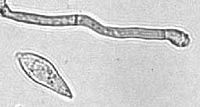Rice blast
| Magnaporthe grisea | |
|---|---|
 |
|
| A conidium and conidiogenous cell of M. grisea | |
| Scientific classification | |
| Kingdom: | Fungi |
| Phylum: | Ascomycota |
| Class: | Sordariomycetes |
| Order: | Magnaporthales |
| Family: | Magnaporthaceae |
| Genus: | Magnaporthe |
| Species: | M. grisea |
| Binomial name | |
|
Magnaporthe grisea (T.T. Hebert) M.E. Barr |
|
| Synonyms | |
|
Ceratosphaeria grisea T.T. Hebert, (1971) |
|
Ceratosphaeria grisea T.T. Hebert, (1971)
Dactylaria grisea (Cooke) Shirai, (1910)
Dactylaria oryzae (Cavara) Sawada, (1917)
Phragmoporthe grisea (T.T. Hebert) M. Monod, (1983)
Pyricularia grisea Sacc., (1880) (anamorph)
Pyricularia grisea (Cooke) Sacc., (1880)
Pyricularia oryzae Cavara, (1891)
Trichothecium griseum Cooke,
Trichothecium griseum Speg., (1882)
Magnaporthe grisea, also known as rice blast fungus, rice rotten neck, rice seedling blight, blast of rice, oval leaf spot of graminea, pitting disease, ryegrass blast, and Johnson spot, is a plant-pathogenic fungus that causes a serious disease affecting rice. It is now known that M. grisea consists of a cryptic species complex containing at least two biological species that have clear genetic differences and do not interbreed. Complex members isolated from Digitaria have been more narrowly defined as M. grisea. The remaining members of the complex isolated from rice and a variety of other hosts have been renamed Magnaporthe oryzae. Confusion on which of these two names to use for the rice blast pathogen remains, as both are now used by different authors.
Members of the Magnaporthe grisea complex can also infect other agriculturally important cereals including wheat, rye, barley, and pearl millet causing diseases called blast disease or blight disease. Rice blast causes economically significant crop losses annually. Each year it is estimated to destroy enough rice to feed more than 60 million people. The fungus is known to occur in 85 countries worldwide.
M. grisea is an ascomycete fungus. It is an extremely effective plant pathogen as it can reproduce both sexually and asexually to produce specialized infectious structures known as appressoria that infect aerial tissues and hyphae that can infect root tissues.
Rice blast has been observed on rice strains M-201, M-202, M-204, M-205, M-103, M-104, S-102, L-204, Calmochi-101, with M-201 being the most vulnerable. Initial symptoms are white to gray-green lesions or spots with darker borders produced on all parts of the shoot, while older lesions are elliptical or spindle-shaped and whitish to gray with necrotic borders. Lesions may enlarge and coalesce to kill the entire leaf. Symptoms are observed on all above-ground parts of the plant. Lesions can be seen on the leaf collar, culm, culm nodes, and panicle neck node. Internodal infection of the culm occurs in a banded pattern. Nodal infection causes the culm to break at the infected node (rotten neck). It also affects reproduction by causing the host to produce fewer seeds. This is caused by the disease preventing maturation of the actual grain.
...
Wikipedia
